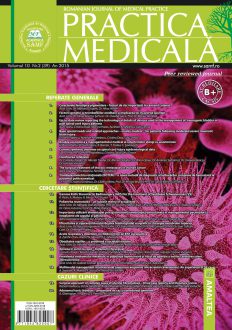SELECT ISSUE

Indexed

| |

|
|
|
| |
|
|
|

|
|
|
|
|
|
|
HIGHLIGHTS
National Awards “Science and Research”
NEW! RJMP has announced the annually National Award for "Science and Research" for the best scientific articles published throughout the year in the official journal.
Read the Recommendations for the Conduct, Reporting, Editing, and Publication of Scholarly work in Medical Journals.
The published medical research literature is a global public good. Medical journal editors have a social responsibility to promote global health by publishing, whenever possible, research that furthers health worldwide.
Multimodal management in intracranial cavernous angiomas (intracranial cavernomas). An experience of 99 cases
A. SASARAN, A. MOHAN, F. STOICA, H. MOISA and A.V. CIUREA
ABSTRACT
Introduction. Intracranial cavernomas are rare neurovascular lesions, met frequently in patients with anomalies of the vasculature of the encephalon and medulla. Cavernomas account for 0.02-0.53% of all intracranial lesions and approximately 8-15% of all intracranial vascular malformations. A procentage of about 10-30% of all cases show an association between cavernomas and arteriovenous malformations. Clinically, the lesions become symptomatic when their size becomes larger than 1cm. The symptoms include headache, seizures, focal neurologic deficit and last but not least hemorrhage.
Materials and methods. The authors present a study of 99 patients diagnosed and treated for intracranial cavernomas between January 2004 and January 2015 (11 years). The study encompasses 45 male patients and 44 female patients with ages ranging between 11 and 56, all treated at the Bagdasar-Arseni Emergency University Hospital in Bucharest, Romania.
A large percentage of the cavernomas were supratentorial 72 cases (72.72%), while only 27 tumors were positioned in the infratentorial compartment of the skull. Regarding the position of the cavernomas, 29 of them (40.27%) were in the frontal lobe, 13 (18.05%) were in the parietal lobe, 20 (27.7%) were in the temporal lobe, while 3 were in the occipital lobe (4.16%). Infratentorial tumors affected the brainstem in 17 cases (62.9%) while 10 cases showed cerebellar implication (37.03%). There were 7 patients in which the authors described multiple cavernomas.
The clinical onset was represented by seizures in 59 cases (59.59%), hemorrhage in 20 cases (20.20%) and focal neurologic deficit in 13 cases (13.13%). The symptoms consisted of seizures in 63 cases (63.63%), focal neurologic deficit in 16 cases (16.16%) and hemorrhage in 23 cases (23.23%) while 9 cases (9.9%) were completely asymptomatic.
The authors chose to practice a conservative management for the 7 cases with multiple lesions, the 9 asymptomatic cases and 5 cases with deep positioning. In the 5 cases with deep cavernomas the patients were subjected to gamma knife stereotactic radiosurgery but only 2 patients showed response to treatment.
Results. In the 99 patients presented by the authors, out of the 76 cases operated, a number of 57 interventions (75%) managed to completeley remove the lesion and perilesional gliosis. A number of 19 interventions only managed to remove the tumor as perilesional gliosis was impossible to remove without lesions to eloquent areas.
Conclusions. Intracranial cavernomas are rare lesions, usually incriminated when seizures appear. When they are asymptomatic the best option for the surgeon is to wait and see how the tumor behaves. When seizures appear in the array of symptoms of a given tumor the best prognosis is offered by lesionectomy with the removal of perilesional gliosis.
Neuronavigation guided surgery has managed in most cases to facilitate complete removal of such tumors and to avoid postoperative defficit with the improvement of clinical results. Furthermore, neuronavigation removes the necessity of an unpleasant stereotactic frame.
When intracerebral hemorrhage occurs, surgery is mandatory and represents a neurosurgical emergency. In multiple tumors, the bleeding cavernoma must be removed. The effectiveness of Gamma Knife Surgery (GKS) is debatable.
Keywords: Intracranial cavernomas, microneurosurgery, seizures, Intracerebral hemorrhage, MRI, neuronavigation, Gamma Knife Surgery (GKS)
